A Rich History
Dalhousie Springs, located in Witjira National Park on the western edge of the Simpson Desert, is a cluster of over 60 natural artesian springs fed by the ancient waters of the Great Artesian Basin. These springs have been bubbling to the surface for thousands of years, forming a rare desert oasis in one of Australia’s most remote regions.
For Aboriginal communities, particularly the Lower Southern Arrernte people, Dalhousie holds deep cultural and spiritual significance. The springs feature in Dreamtime stories and were vital for survival, with archaeological evidence of large campsites and stone artefacts scattered throughout the area.
The springs were named in the 1870s by surveyor Richard Randall Knuckey during work on the Overland Telegraph Line. By the early 20th century, Dalhousie was known for its impressive flow rate—over 23,000 litres per second in 1915—though this has since declined due to bore drilling across the basin.
In 2009, Dalhousie Springs was added to the Australian National Heritage List, recognising its ecological, geological and cultural importance. Today, it remains a popular stop for Simpson Desert travellers, offering warm waters, rich biodiversity and a rare glimpse into Australia’s ancient natural systems.
unique ecological hotspot
Dalhousie Springs is more than just a thermal oasis—it’s a unique ecological hotspot nestled within Witjira National Park. The constant flow of warm artesian water creates a rare wetland environment in the middle of the desert, supporting species found nowhere else in Australia.
Flora
The springs are fringed by dense reeds, tall grasses and river red gums, forming a lush contrast to the surrounding arid scrub. You’ll also find:
- Coolabah trees and Melaleuca species around the spring mounds
- Cryptobiotic crusts and gypsiferous soils supporting salt-tolerant plants
- Algae and microbial mats thriving in the warm waters, including emerald green filamentous algae and sulphur-loving bacteria
These plant communities help stabilise the soil, filter water and provide shelter for native animals.
Fauna
Dalhousie’s warm waters and shaded edges attract a surprising diversity of wildlife:
- Birds: Galahs, corellas, zebra finches and occasional raptors
- Reptiles: Skinks, geckos and snakes adapted to desert conditions
- Invertebrates: Mosquitoes, dragonflies and rare aquatic insects
- Mammals: Dingoes are often seen at dawn or dusk, and small marsupials may be spotted near campsites
The springs also support endemic aquatic species, including a rare fish known as the Dalhousie hardyhead, which has adapted to the high temperatures and mineral content of the water.



